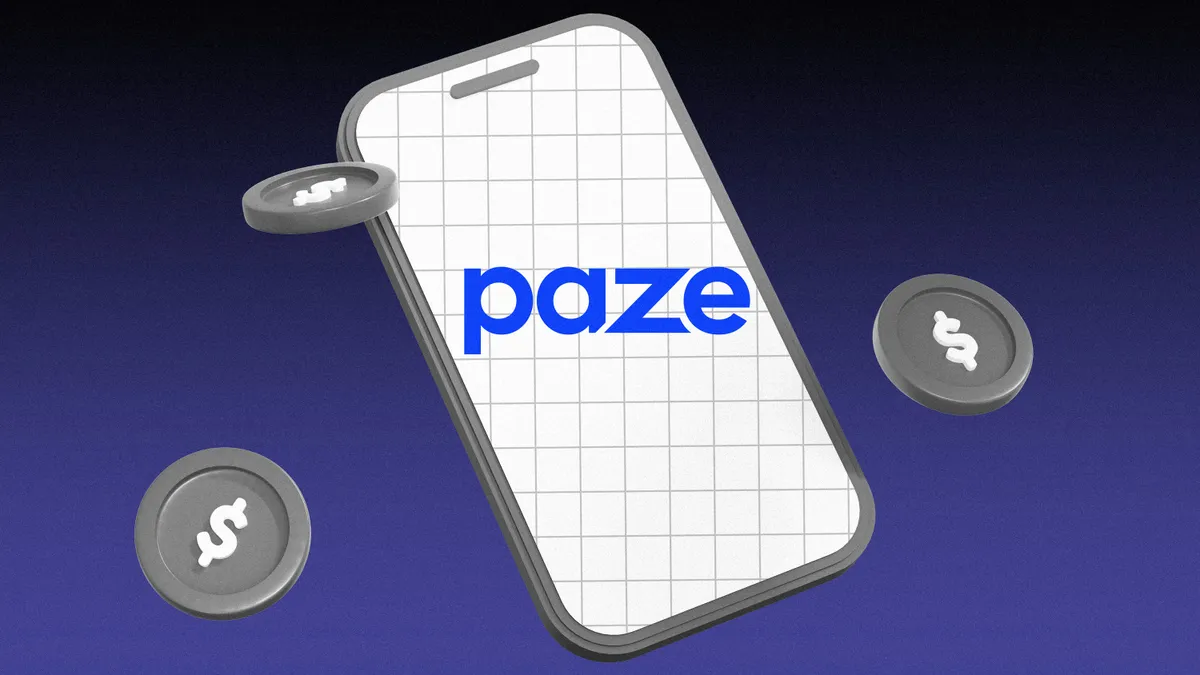Early Warning Services, the operator of the bank-owned peer-to-peer payments platform Zelle, has big ambitions for a new digital wallet it says will make e-commerce payments easier for consumers and merchants.
Like Zelle, the new product, called Paze, will be owned and operated by seven of the nation’s largest banks. The digital wallet is set to go live with merchants and member banks in June before a wider rollout in the fall, EWS said.
“This program has been designed from day one to be something that is available to all financial institutions in the U.S., large or small,” said Paze Managing Director James Anderson, a former Mastercard executive who joined EWS in August to head up the bank wallet program. “Our ultimate objective is ubiquity of access to Paze, both on the consumer side and on the merchant side.”
But launching a novel wallet, even with the backing of the nation’s largest banks, will be no easy feat, according to some industry experts, who say Paze will have its fair share of adoption and security hurdles to overcome to grab a slice of the digital wallet market.
The network effect
EWS, which launched Zelle in 2017, is betting Paze can mirror and ultimately surpass that P2P payments platform’s consumer adoption rate.
“You want to be more than just present,” said Anderson, on EWS’s initiatives to bring payment services back into the banking system. “You want to be in front of the queue, top of the consumer’s mind and perceived as the solution provider. I think that's what Zelle enabled in P2P. And that's what Paze is going to enable in merchant payments.”
More than 1,800 financial institutions are part of the Zelle network, according to figures EWS released in February.
The platform’s network of banks increased by 40% in 2022, EWS said, adding that 97% of the institutions that joined last year have under $10 billion in assets.
Consumers and businesses sent 2.3 billion payments totaling $629 billion through Zelle in 2022, EWS said.
Seven of the nation’s largest banks, including JPMorgan Chase, Bank of America and Wells Fargo, make up the consortium of institutions that owns EWS. That means Paze will automatically be loaded onto 150 million Visa and Mastercard accounts on day one, Anderson said.
But simply placing Paze at consumers’ fingertips doesn’t mean banks will automatically overcome the adoption hurdle, said Charlotte Principato, a financial services analyst at Morning Consult.
“It’s a flawed premise that banks have or are holding on to being the primary provider for their consumer relationships. I think that that is a bank-centric notion,” she said. “Folks don't have monogamous financial services relationships. Everyone uses multiple apps to cobble together the type of financial providers that work for them.”
Paze is launching amid a crowded and competitive marketplace, one in which users of one digital wallet are likely to use others as well, according to data from Morning Consult.
Close to 90% of Apple Pay users say they also use PayPal, and nearly every user of any competitor digital wallet also uses PayPal, according to a study the research company released in February.
Meanwhile, 65% of Google Pay users said they also use the Block-owned Cash App, and more than half of Cash App users also use PayPal-owned Venmo, the study found.
It’s imperative that EWS’s digital wallet has a top-of-the-line customer experience if it wants to differentiate from other players and become the primary digital wallet provider for consumers, Principato said.
That will be a tough hurdle for Paze, given the stiff competition from well-entrenched players Apple and Samsung, said Seth Ruden, director of global advisory at fraud prevention fintech BioCatch.
“It certainly is going to be hard,” he said. “They've got an amazing user experience already. That’s Apple's bread and butter. Their design philosophy and their user experience is likely one of their strongest value articulations.”
Paze gives banks an opportunity to participate in the digital wallet race and stay relevant, Principato said.
“But I don't think it's a way for them to rise, in the minds of consumers, as beating out Apple Pay or PayPal,” she added.
Winning over merchants
Consumers are disloyal with digital wallets because not every merchant or retailer accepts every wallet, Principato said.
“While this is great news for banks in the sense that customers don’t seem to have a limit to the number of digital wallets they’ll sign up for, it doesn’t guarantee they’ll actually use a new wallet with any frequency,” she said.
That’s why winning over merchants is key, Principato said.
Anderson touted Paze’s immediate reach, saying the more than 150 million accounts that will have access to Paze, after launch, gives the platform “a more than relevant starting point,” which will incentivize merchants to adopt the digital wallet.
“And we have the opportunity to expand beyond that,” Anderson said.
While that's enticing from a merchant standpoint, Principato said banks will need to show that Paze is capturing a new set of consumers.
“The banks will have to show some hard numbers of who those people are,” she said. “Why would a merchant add this other way to pay if the other digital wallets are already capturing anyone who would be interested in purchasing from them?”
But Anderson said EWS is confident merchants are recognizing the value of Paze.
“They really like the idea that this is something that comes from the banks and is endorsed by the bank, and therefore comes with credibility and reassurance at the bank,” he said.
Ron de Bos, director of payments at e-commerce, payments and marketing services firm Digital River, said he expects merchants to respond positively to Paze, so long as banks prove that they can hold up their end of the bargain with regard to express checkout.
“Existing brand reputation should go a long way in fostering trust, and that may lower some barriers to quick adoption, but banks need to make sure they can process transactions as quickly as competitors can to make their offerings amenable to merchants and consumers alike,” he said.
Will banks have an edge?
Like Zelle, a clear differentiator between Paze and its digital wallet competitors is its connection to regulated financial institutions. But whether consumers believe that connection boosts the platform’s trustworthiness over other digital wallets remains to be seen.
De Bos said banks will have an advantage here.
“Consumers go to banks for peace of mind. If they apply the same security principles to digital wallets as they already do to online banking operations, the appeal should be widespread,” he said. “Client adoption could be an issue, but the secure and reputable profile, combined with the fact that these may be consumers’ home banks, provides an additional advantage that makes this pursuit worthwhile.”
Principato, however, isn’t convinced banks’ reputations will give them a competitive edge in the digital wallet race.
“I don't think it's a fair assumption on the part of banks to say that consumers are going to use [Paze] because they're going to assume it’s safer,” she said. “If anything, Apple has been much more privacy- and safety-focused in their marketing efforts than banks have been.”
Meanwhile, EWS’s digital wallet could be a prime target for bad actors looking to exploit any unidentified weaknesses on the platform, Ruden said.
“[EWS] might have some brilliant ways to secure this channel,” he said. “But the reality is, any new channel that gets created has the opportunity for exploitation, especially in the early days when adoption is starting to ramp up.”
Anderson said EWS is adding multiple layers to Paze aimed at ensuring the security of the platform.
“The consumer has the right to dispute a transaction, to perform a chargeback and ultimately to get their money back,” he said, adding, all transactions performed through Paze will be card transactions. “Those rights and benefits will be the same if a transaction is conducted through Paze as if it was conducted any other way. That's a sort of foundational layer.”
EWS said it has also designed protections around Paze’s wallet claim process. Users can claim their wallets by logging into the digital property of a participating financial institution, Anderson said.
Consumers also have the option to claim their wallet when checking out at a participating merchant’s site, Anderson added.
And for every transaction performed through Paze, consumers receive a one-time passcode to the consumers’ phone via SMS, he added.
“That's a layer of protection on every single usage,” he said. “We're ensuring that it's the consumer every time the wallet’s used.”
EWS’s member banks have a significant amount of resources to devote to Paze’s rollout, as well as initiatives focused on encouraging consumers to use it, Ruden said.
“This is going to require a lot of effort on their part to make sure that retailers and consumers are all going to be on an adoption pathway,” he said. “[But] that begins the problem of fraud. The more you open up adoption, the greater the likelihood that fraud starts to aggregate.”
Data opportunity?
It’s not yet clear how much of a consumer data opportunity Paze presents for participating banks, Principato said.
“It seems like they're still using the same payment rails as other digital wallets, in terms of really working with Visa and Mastercard,” she said. “I don't think there is a ton more to be gained in terms of the individual interaction, or sales data that they'll have.”
Paze could give banks a better understanding of consumers’ cash flow and day-to-day purchases, but as long as consumers continue to use multiple digital wallets, banks won’t be getting a complete picture, Principato said.
While the opportunity for data collection offers strong appeal in the adoption of any new digital channel, interested banks will likely be joining Paze for other reasons.
“The opportunity for data collection … is likely a consideration here,” De Bos said. “More likely, though, is that banks recognize the need to keep pace in the fast-evolving payments world, as super apps, digital wallets and the like all threaten to supplant traditional cards.”



















